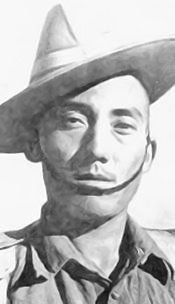Slouch hat
Slouch hat is a type of wide-brimmed hat most commonly worn as part of a military uniform, often, although not always, with a chinstrap. It has been worn by military personnel from many different nations including Australia, Britain, India, New Zealand, Southern Rhodesia, France, and the United States. It is also popular with civilian populations as fashion accessories.
History[edit | edit source]
The slouch hat originated in the mid-19th century as part of the uniform of the Australian military. It gained popularity during the Second Boer War where it was used by British troops and was noted for its practicality in the hot, sunny climate of South Africa. The hat's design allows for flexibility in wear; it can be shaped to suit the wearer's preference, often tilted to one side to allow for better vision or airflow.
Design and Features[edit | edit source]
The slouch hat is made from materials such as felt or wool and is characterized by its wide brim and high crown. The brim is typically downturned at the front and rear to protect the wearer's face and neck from the sun and rain. One side of the hat brim is often pinned up against the crown of the hat, which allows for a rifle to be slung over the shoulder without interference from the hat. This distinctive style has become a symbol of Australian military heritage, particularly the Australian Light Horse units of World War I.
Cultural Significance[edit | edit source]
In Australia, the slouch hat has become a symbol of national pride and military history. It is closely associated with ANZAC (Australia and New Zealand Army Corps) Day and Remembrance Day ceremonies, where it is worn as part of the ceremonial dress. The hat symbolizes the bravery, resilience, and the spirit of the ANZACs.
Military Use[edit | edit source]
The slouch hat is still in use today by various military units. In the Australian Army, it is part of the uniform for ceremonial occasions, worn with the brim pinned up on the left side to accommodate the Australian Army badge. Other countries have adopted the slouch hat for similar reasons, valuing its practicality and the protection it offers from the elements.
In Popular Culture[edit | edit source]
The slouch hat has made appearances in various films, television shows, and literature, often used to depict Australian soldiers or characters with a rugged, outdoor persona. Its distinctive shape and association with the military make it a recognizable and enduring symbol of toughness and adventure.
Conclusion[edit | edit source]
The slouch hat is more than just a piece of military attire; it is a symbol of history, culture, and identity for many nations, particularly Australia. Its practical design and cultural significance have ensured its continued use and popularity both in military contexts and in civilian fashion.
Search WikiMD
Ad.Tired of being Overweight? Try W8MD's physician weight loss program.
Semaglutide (Ozempic / Wegovy and Tirzepatide (Mounjaro / Zepbound) available.
Advertise on WikiMD
|
WikiMD's Wellness Encyclopedia |
| Let Food Be Thy Medicine Medicine Thy Food - Hippocrates |
Translate this page: - East Asian
中文,
日本,
한국어,
South Asian
हिन्दी,
தமிழ்,
తెలుగు,
Urdu,
ಕನ್ನಡ,
Southeast Asian
Indonesian,
Vietnamese,
Thai,
မြန်မာဘာသာ,
বাংলা
European
español,
Deutsch,
français,
Greek,
português do Brasil,
polski,
română,
русский,
Nederlands,
norsk,
svenska,
suomi,
Italian
Middle Eastern & African
عربى,
Turkish,
Persian,
Hebrew,
Afrikaans,
isiZulu,
Kiswahili,
Other
Bulgarian,
Hungarian,
Czech,
Swedish,
മലയാളം,
मराठी,
ਪੰਜਾਬੀ,
ગુજરાતી,
Portuguese,
Ukrainian
Medical Disclaimer: WikiMD is not a substitute for professional medical advice. The information on WikiMD is provided as an information resource only, may be incorrect, outdated or misleading, and is not to be used or relied on for any diagnostic or treatment purposes. Please consult your health care provider before making any healthcare decisions or for guidance about a specific medical condition. WikiMD expressly disclaims responsibility, and shall have no liability, for any damages, loss, injury, or liability whatsoever suffered as a result of your reliance on the information contained in this site. By visiting this site you agree to the foregoing terms and conditions, which may from time to time be changed or supplemented by WikiMD. If you do not agree to the foregoing terms and conditions, you should not enter or use this site. See full disclaimer.
Credits:Most images are courtesy of Wikimedia commons, and templates, categories Wikipedia, licensed under CC BY SA or similar.
Contributors: Prab R. Tumpati, MD




